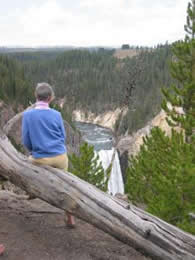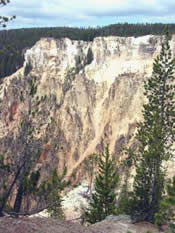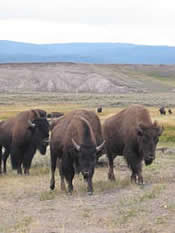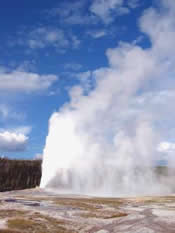
Take a Hike through Yellowstone National Park
by
Linda Aksomitis
 |
| Lookout
Point in Yellowstone's Grand Canyon. |
The ledge was wide enough for two of us to walk side-by-side-to my right the lodgepole
pines rose majestically out of what seemed to be solid rock. On the left, with
a sheer drop of a thousand feet, lay the bottom of Yellowstone's Grand Canyon.
I wondered, for the tenth time at least, what I, a hiker with a definite fear
of heights, was doing on the trail!
Hiking
the South Rim Trail took me past some of the most breathtaking views in the World's
first National Park-Yellowstone, which was established in 1872. From Lookout Point
I watched the 310 feet of the cascading Lower Falls from across the canyon. I
took a deep breath and edged out further with my camera. An old log lay in front
of me, like an anchor on the mountain, so I leaned into it, ready to snap my picture.
My bravery
only went so far. When the log quivered under my touch I leapt back onto the path,
finding safety in the trail that had seemed far too narrow a few minutes earlier.
My companion, who'd done a lot of rock climbing in California, grinned, leaned
out from the ledge and snapped a picture for me. I turned my attentions to a squirrel
chattering at me in a nearby tree, while I waited for my heart to slow down.
I
kept my eyes focused on the top of the opposite canyon wall for a while. It was
almost flat, with a large growth of trees-the ice age that plowed through the
area ripping up solid chunks of rock to create the canyon must have been a truly
magnificent period. Around me the rock was almost in tiers, so I let my gaze follow
them, dropping again to the bottom.
This
time my stomach stayed where it belonged instead of catapulting into my throat
like it had with my first glances. I said to Linda, my partner, "This was
the focus of last night's Imax movie about Yellowstone, wasn't it?"
She
nodded, and leaned out a little further. "It's awesome, isn't it?"
Indeed,
the camera had flown us through the bottom of the canyon, looking up instead of
down, then swooped like a bird to the heights. The dizzying effects were no more
dazzling than actually standing where I was on the lookout. There was no denying
that Yellowstone's Grand Canyon was incredible.
Jim Berry, our guide from the Yellowstone Alpen Guides, came up to enjoy the view beside us. "Careful ladies," he advised, "this rock crumbles, so don't stand directly on the edge. It's not good for rock climbing."
That was enough of a warning to keep me back a few extra feet. We resumed our hike, meeting others coming in our direction. Overhead the canopy of trees was filled with the chirps and hoots of birds offended by our presence.
 |
| Yellowstone's Grand Canyon. |
The South Rim Trail had two choices: Uncle Tom's Trail and Chittendon Bridge. With so much to see in Yellowstone I opted not to take the trail down to the bridge at the bottom of the falls. Hiking another twenty minutes I stopped frequently to check my progress over the canyon. Each angle provided another perspective of its beauty. When we reached the parking lot I was reluctant to climb into the van seat -- walking on the eons old rim of the canyon put me in touch with the earth in a way I hadn't expected.
I'd entered Yellowstone around 6 a.m. hoping to encounter some of the early morning wildlife and hear the howl of wolves or the mating call of the bull elk. While the sounds had eluded me, I found several herds of elk, which was to be expected considering the park is home to around 35,000 of the graceful creatures. The first ones I saw wandered around the brick buildings, munching on the lawns in what had been the barracks area of Fort Yellowstone, decades earlier. Later, I watched the Madison Elk herd graze in the wilds of the Madison Valley.
Indeed, I visited Yellowstone during its secret season, when the call of nature is at its strongest. During late August the bison, or buffalo, are weaning their young, and the mating ritual takes priority. For two or three weeks of the year the male and female bison run together, partnering in an elaborate courtship ritual.
Less than twenty feet from me, at the top of a rise, a bull, his outline a shadow against the dark clouded sky, bellowed his anguish at the female's disinterest. His horn plowed up a furrow in the sod, as he tossed his head again and again. Finally he threw his powerful shoulders to the ground, rolling in the dirt. A cloud of dust blew up around him, but the cow continued to stare straight ahead.
 |
| A bison herd at Yellowstone National Park. |
A herd of bison, forty or more animals, along with calves, grazed in the long grasses along the edge of the pavement. An old bull, far more powerful looking than the yearlings around him, snorted and pursued the nearest female. I trod carefully, getting as close to the herd as I dared -- about as close as I'd been to the rock ledge, and snapped my pictures.
Dragging myself away from the animals, I continued the loop around Yellowstone, a place nothing short of a miracle of nature itself. The Park has over 9000 hotsprings, or half of all that exist in the world; 400, or 2/3 of all the geysers in the world; and 12 of the 13 giant geysers in the world (a giant geyser shoots over 100 feet or more). The park is protected in its natural state, so only plants or animals indigenous to the area may be introduced. It is home to 500 black bears, 250 wolves, 350 grizzly bears, 300 moose, 300 bighorn sheep, and numerous other common animals like mule deer.
During the day Jim also told me more about geological formations than I'd learned in my lifetime. From the columnar basalt rock, which looks like the palisade of an old fort but is a natural rock formation; to the Fountain Paint Pots, where sulfuric acid is generated, melting the surrounding rock into a bubbling mass, I was mesmerized with the power of nature.
 |
| Old Faithful. |
And of course, a day in Yellowstone isn't complete without visiting Old Faithful. Sure enough, after a brief wait the world's most famous geyser erupted right on schedule about 5:45 that afternoon.
Fascinated by the steam shooting into the sky, I joined hundreds of people enjoying the secret season of Yellowstone National Park. My day had disappeared with the blink of an eye, and I was on my way back to West Yellowstone to dream about standing at the edge of world, in awe of nature.
For online tours of Yellowstone's geological features visit: http://www.nps.gov/yell/nature/geology/
To visit the area, check out West Yellowstone at: http://www.westyellowstonecvb.visitmt.com/